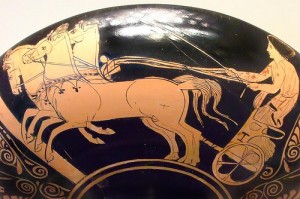Horse racing has a long and rich history. It is thought to have begun in 4500BC, with the prehistoric nomadic tribesmen from central Asia (the first to domesticate the horse around this time).
In 638BC, mounted horse racing and chariot horse racing were seen in the Greek Olympics. During this time, horse racing became an organized sport across central Asia and the Mediterranean and it became a public obsession in the Roman Empire.
Jump to the 12th century (1101-1200) and one will find the origins of modern horse racing. The English knights returned from the Crusades with Arabian horses and, for the next 400 years, the English improved their horses by importing more and more Arabian stallions to breed with their English mares. This produced horses that had both speed and endurance. At the time, two-horse races were the most popular form of entertainment among the nobility.
The year 1530 marks the earliest records of horse racing in England. Two-horse match races are still the most popular form of horse racing and it is still very much a sport of the nobility (the lower classes lacked the money to be able to partake in horse racing).
In 1665, horse racing was brought to the New World by British settlers. The first American racetrack was installed in Long Island. The next two centuries would see tracks pop up and disappear around the New York area.
In the early 1700s (in England), during the reign of Queen Anne, horse racing started to become a professional sport when match racing was replaced with races involving several horses, on which spectators would wager. Race courses would offer larger and larger purses to attract the best horses to their course and this made breeding and owning racehorses a very profitable endeavor.
By the mid-1700s, a central governing authority was needed, so The Jockey Club was formed at Newmarket. The Jockey Club wrote complete rules of racing and sanctioned racecourses to conduct meetings under those rules. In 1791, The Jockey Club set about regulating the breeding of racehorses, which led to the creation of the General Stud Book.
In the early 1800s, the only horses allowed to be called Thoroughbreds (and, therefore, be allowed to race) were those that were descended from horses listed in the General Stud Book. The pedigree of every single Thoroughbred can be traced back to one of three stallions (known as the “foundation sires”): the Byerley Turk, the Darley Arabian, and the Godolphin Arabian.
The first Kentucky Derby was held on May 17th, 1875. Today, it is one of the most famous races in the United States and it is the first of three races that make up the American Triple Crown.
1890 saw the rapid rise of an industrial economy and of gambling on racehorses. The popularity of horse racing exploded.
Without a central governing authority in the US, the rapid growth of horse racing led to many tracks being dominated by criminal elements. In 1894, the American Jockey Club was created and it ruled with an iron hand, eliminating most of the corruption that had developed within the sport.
The late 19th century saw the advent of the pari-mutuel wagering system and it is still the betting system used today.
Racing in the US was almost completely wiped out in the early 1900s by an anti-gambling sentiment that led to almost all the states banning legalized betting. In 1908, there were only 25 tracks in the US. That year, pari-mutuel betting was introduced for the Kentucky Derby and more tracks opened when many state legislatures agreed to legalize this form of betting in exchange for a share of the money wagered.
The 1950s and the 1960s saw a decline in popularity for the sport (caused in part by World War II) but the 1970s brought about a revival in public interest because of horses like Secretariat, Seattle Slew, and Affirmed (all winners of the American Triple Crown).
The late 1980s saw another significant decline, although horse racing was the second most widely attended US spectator sport after baseball.
Today, Thoroughbred tracks exist in about half of the states. Public interest in horse racing focuses predominantly on major races, such as those that make up the American Triple Crown (the Kentucky Derby, the Preakness, and the Belmont Stakes) and the Breeders’ Cup race, all of which offer purses of about 1 million dollars.
The American Jockey Club and the British Jockey Club (now known as the British Horseracing Authority) still govern the rules of racing, though in the US, state racing commissions have sole authority to license participants and to grant racing dates.
Source: Animal Planet. Jockeys: a history of horseracing. 2011. Available at: http://www.finden.gr/asp/JOCKEYS_HISTORY_OF_HORSE_RACING.pdf. Accessed: April 1st, 2012.

